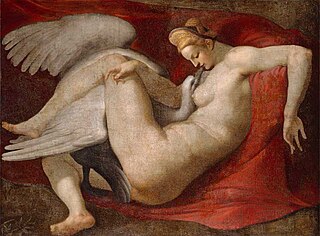 W
WLeda and the Swan is a story and subject in art from Greek mythology in which the god Zeus, in the form of a swan, seduces or rapes Leda. According to later Greek mythology, Leda bore Helen and Polydeuces, children of Zeus, while at the same time bearing Castor and Clytemnestra, children of her husband Tyndareus, the King of Sparta. In the W. B. Yeats version, it is subtly suggested that Clytemnestra, although being the daughter of Tyndareus, has somehow been traumatized by what the swan has done to her mother. According to many versions of the story, Zeus took the form of a swan and raped Leda on the same night she slept with her husband King Tyndareus. In some versions, she laid two eggs from which the children hatched. In other versions, Helen is a daughter of Nemesis, the goddess who personified the disaster that awaited those suffering from the pride of Hubris.
 W
WLeda and the Swan is an oil on canvas painting from 1530–31 by the Italian painter Correggio, now in the Gemäldegalerie in Berlin. It shows three scenes of Leda's seduction by Jupiter who has taken the form of a swan. Their first meeting is shown on the right hand side and their lovemaking in the centre, where Leda sits with the swan between her thighs, guiding him with her left hand. They are accompanied to their left by Cupid with his bow and two cupids with flutes. The third scene is the swan flying away whilst Leda gets dressed. Leda and the Swan was a common subject in 16th-century art.
 W
WLeda Atomica is a 1949 painting by Salvador Dalí. The picture depicts Leda, the mythological queen of Sparta, with the swan. Leda is a frontal portrait of Dalí's wife, Gala, who is seated on a pedestal with a swan suspended behind and to her left. Different objects such as a book, a set square, two stepping stools and an egg float around the main figure. In the background on both sides, the rocks of Cap Norfeu define the location of the image.
 W
WLeda and the Swan is a tempera grassa on panel painting by an artist from the circle of Leonardo da Vinci, probably Cesare da Sesto. It dates to c.1510-1520 and is now in the Galleria Borghese in Rome. It and other versions at Wilton House and the Uffizi are considered the three best copies after Leonardo's own lost Leda and the Swan.
 W
WKneeling Leda with Her Children is a 16th-century painting by Leonardo da Vinci's pupil Giampietrino. It is now in the Gemäldegalerie Alte Meister (Kassel).
 W
WStabiae was an ancient city situated near the modern town of Castellammare di Stabia and approximately 4.5 km southwest of Pompeii. Like Pompeii, and being only 16 kilometres (9.9 mi) from Mount Vesuvius, this seaside resort was largely buried by tephra ash in 79 AD eruption of Mount Vesuvius, in this case at a smaller depth of up to five metres.
 W
WThe story of Leda and the Swan was the subject of two compositions by Leonardo da Vinci from perhaps 1503–1510. Neither survive as paintings by Leonardo, but there are a number of drawings for both by him, and copies in oils, especially of the second composition, where Leda stands.
 W
WLeda and the Swan is a lost tempera on canvas painting by Michelangelo, produced in 1530 but now only surviving in copies and variants. The work depicted the Greek myth of Leda and the Swan.
 W
WLeda and the Swan, by Peter Paul Rubens, who painted two versions of this subject. The first was completed in 1601 and the second in 1602.
 W
WLeda and the Swan is a c.1550-1560 oil on canvas painting by Jacopo Tintoretto. Doubts on its autograph status were quelled by its restorations in 1988 and 1994. Art historians do not agree on its dating, though most now place it in the 1550s, the same period as his Mars and Venus Surprised by Vulcan and Joseph and Potiphar's Wife. Judith and Holofernes (Prado) was also previously dated to that decade but has now been downgraded to a studio work.
 W
WLeda and the Swan is a c.1505-1507 oil and resin on panel painting by a painter in the circle of Leonardo da Vinci. It may have originated in the Gualtieri Collection in L'Aquila and passed through various others before being acquired from the Spiridon Collection in 1989 by its present owner, the Uffizi.
 W
WLeda and the Swan is a c.1515 painting by Cesare da Sesto, a painter in the circle of Leonardo da Vinci. It is now in Wilton House near Salisbury, UK. With other versions now at the Galleria Borghese and Uffizi, it is thought to be one of three of the closest copies after Leonardo's own lost work on the subject.